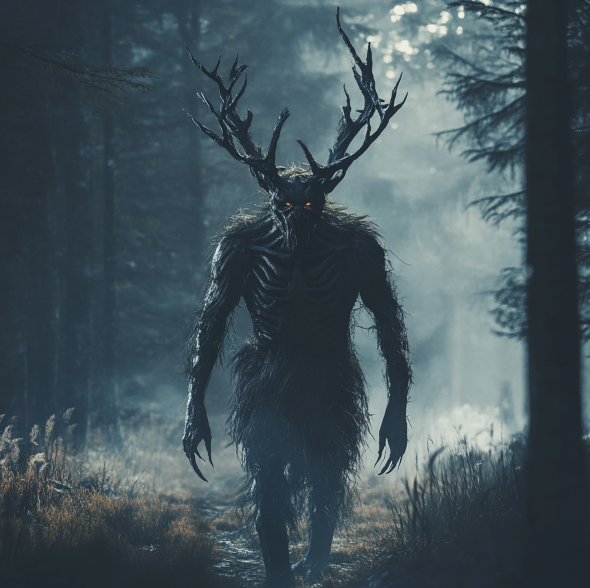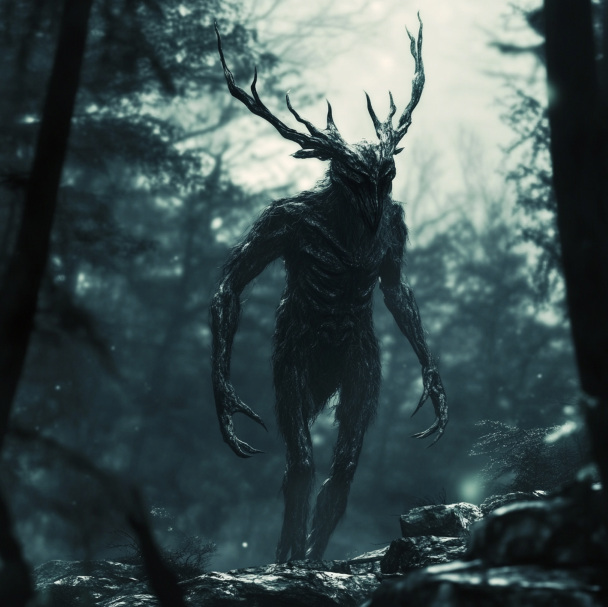The Wendigo is a chilling figure rooted in the folklore of North America’s indigenous peoples, predominantly the Algonquian-speaking tribes. This mysterious cryptid is often depicted as a malevolent spirit or creature that embodies greed, hunger, and the cold isolation of the harsh northern forests.
Culturally, the Wendigo holds significant importance as a cautionary tale. It serves as a grim reminder of the dangers of selfishness and excess, particularly in the context of survival during brutal winters.
As noted by folklore expert Dr. Jane Smith, “The Wendigo myth reflects profound cultural fears surrounding isolation and the struggle to maintain humanity in dire circumstances.”
This article delves into the origins, cultural depictions, and modern interpretations of the Wendigo, exploring how this captivating myth continues to influence and inspire contemporary storytelling.
Origins of the Wendigo Myth
Roots in Algonquian Folklore
The Wendigo, also known as Wétiko, emerges from the deep-seated cultural narratives of Algonquian-speaking tribes. This mythical creature is more than a figure of horror; it embodies significant moral lessons about the dangers of greed and insatiable hunger, often connected to the harsh realities faced by these communities.
- Ojibwe
- Cree
- Innu
- Saulteaux
Connection to Harsh Winters and Survival
In Algonquian traditions, the Wendigo myth is intricately linked to survival during brutal winters. The chilling tales often arise from periods of starvation, where the threat of cannibalism loomed large, symbolizing the struggle to maintain humanity in dire circumstances. Such narratives highlight the community’s emphasis on cooperation and the consequences of succumbing to selfish desires.

Transformation of Humans into Wendigos
The transformation of humans into Wendigos is a central theme in Native American folklore. This metamorphosis can result from encountering the creature, being possessed by it in dreams, or engaging in cannibalism. The legend serves as a stark warning against losing one’s humanity, as depicted in various tribal stories.
Understanding these origins sheds light on how the Wendigo myth continues to resonate, symbolizing the eternal battle between communal values and personal greed.
Cultural Depictions of the Wendigo
The Wendigo has emerged as a chilling figure in literature and film, often stripped of its original cultural significance. In Stephen King’s *Pet Sematary* and the television series *Hannibal*, the Wendigo is portrayed as a flesh-eating monster, emphasizing its insatiable greed and hunger for human flesh. These portrayals overshadow its deeper moral implications within Algonquian traditions.
| Media | Wendigo Characteristics | |
| Pet Sematary | Flesh-eating monster, insatiable greed | |
| Hannibal | Monstrous figure, cannibalistic nature | |
| Antlers (2021) | Native exposition, focus on white community’s struggle |
Such representations highlight the Wendigo’s use as a plot device in horror narratives, often detached from its original context. Yet, the myth continues to influence popular culture, offering a lens through which to critique societal values and explore themes of greed and exploitation. As we delve deeper into modern mythology, the Wendigo remains a powerful symbol of both horror and moral reflection.
Characteristics of the Wendigo
The Wendigo is an unsettling figure in folklore, with its haunting features and supernatural prowess.
- Physical Description: The Wendigo is often depicted as a gaunt, emaciated creature with desiccated skin that clings tightly to its skeletal frame. It has an ash gray complexion, deep-set eyes, and tattered lips, if any remain. The creature’s body is unclean, often emitting an odor of decay and decomposition. In some legends, it is described as a giant with a heart of ice, or as a creature as tall as a tree with glowing eyes, jagged teeth, and terrible claws.
- Supernatural Abilities: The Wendigo is imbued with malevolent powers, often portrayed as a spirit associated with cannibalism. It possesses enhanced strength, speed, and regenerative abilities, allowing it to endure harsh conditions. The Wendigo can manipulate the environment and instill profound fear in its victims, adding to its terrifying reputation.
- Psychological Attributes: The Wendigo symbolizes excess, gluttony, and greed. It reflects the psychological struggle between survival instincts and cultural taboos against cannibalism. The concept of Wendigo psychosis explores these themes, manifesting as a cultural-bound syndrome where individuals believe they are possessed by the creature, driven by desperation and loss of control.
These characteristics make the Wendigo a formidable figure in both folklore and modern interpretations, encapsulating fears of isolation, starvation, and the loss of humanity.
Wendigo in Modern Mythology
Urban Legends and Sightings
The Wendigo continues to haunt the imaginations of people in Northern Minnesota and beyond. Historical sightings date back to the late 1800s, often shrouded in mystery and linked to sudden, unexplained deaths. These stories, such as the infamous Swift Runner case, where isolation and starvation led to tragic events, keep the legend alive in modern times. Jack Fiddler’s accounts of battling Wendigos further cement the creature’s place in folklore, highlighting the fear of transformation into this malevolent being.
Role in Horror Stories and Games
In contemporary media, the Wendigo has found a chilling role in horror genres, such as the video game Until Dawn. Here, Wendigos are depicted as terrifying, skeletal monsters that bring an intense sense of dread. Their portrayal in such narratives emphasizes psychological and physical terror, enhancing the horror experience for audiences.
“The Wendigo is not just a monster; it’s a metaphor for the darkness that can consume us,” says Dr. Jack D. Forbes, a scholar of Algonquian mythology.
Symbolism in Contemporary Culture
Beyond entertainment, the Wendigo symbolizes unchecked greed and the devastation it can cause. This extends into critiques of modern society, where scholars like Forbes use the Wendigo as a metaphor for imperialism and exploitation. The creature’s transformation narrative serves as a cautionary tale, urging reflection on human actions and their broader impact. As such, the Wendigo remains a potent symbol in both horror and cultural discourse.
Debunking Wendigo Myths
The Wendigo, steeped in Native American folklore, is often misunderstood due to its portrayal in modern media. Let’s separate fact from fiction and clarify its origins.
- Misunderstandings about Origins: The Wendigo originates from Algonquian mythology, embodying themes of insatiable greed and cannibalism. It is not merely a creature from horror stories but a cultural symbol warning against selfishness and excess.
- Fictional Elements: Many modern depictions, like those in video games and films, transform the Wendigo into a monstrous villain. These portrayals emphasize horror over cultural context, stripping it of its original purpose as a moral lesson.
- Fact vs. Fiction: While fictional tales dramatize the Wendigo with supernatural powers, reality reflects a psychological condition known as Wendigo psychosis. This condition, historically documented, involves intense cravings for human flesh during extreme isolation.
Understanding these distinctions helps preserve the Wendigo’s cultural significance while appreciating its role in storytelling. It’s crucial to recognize the creature as more than a horror trope, but as a symbol with deep roots in indigenous culture and history.

Psychological Interpretations
The Wendigo legend is not just a chilling tale but also a profound cultural narrative that delves into the psychological realms. At the heart of this myth is Wendigo psychosis, a culture-bound syndrome where individuals believe they are possessed by this insatiable creature. This condition, historically reported among certain Native American communities, is characterized by symptoms like delusions, anxiety, and cannibalistic urges.
Culturally, the Wendigo myth serves as a warning against greed and extreme isolation, entwining cultural beliefs with mental health perceptions. It reflects how environmental stressors and community dynamics during times of scarcity can shape mental health experiences. The myth underscores the need for social cohesion, suggesting that succumbing to selfishness and gluttony could lead to psychological turmoil.
The symbolism of the Wendigo extends to psychological interpretations, portraying the internal struggle between human nature and societal norms. It highlights the psychological defense mechanisms employed to cope with the taboo of cannibalism, reflecting deeper themes of morality and survival. In essence, the Wendigo represents the dangers of yielding to base instincts and the profound impact of cultural narratives on mental health.
Scientific Perspectives on the Wendigo
The Wendigo myth, while deeply rooted in cultural folklore, has attracted scientific scrutiny over the years. Skeptics and researchers alike have sought to demystify this legendary creature through rigorous scientific analysis. A primary focus has been on Wendigo psychosis, a culture-bound syndrome that mirrors known psychological conditions like schizophrenia and bipolar disorder. Symptoms such as paranoia, anxiety, and hallucinations provide a fascinating parallel for researchers exploring the intersections between cultural narratives and mental health.
Research indicates that instances of Wendigo psychosis were notably prevalent during periods of extreme scarcity among Algonquian tribes, suggesting a historical context for this psychological phenomenon. Studies highlight how environmental stressors, akin to those triggering PTSD or depression, can influence psychological conditions, reinforcing the importance of a multidisciplinary approach to understanding the Wendigo.
While media portrayals often skew the cultural significance of the Wendigo, scientific studies continue to explore its psychological implications and cultural roots. These efforts not only aim to separate fiction from fact but also to enhance our understanding of how myths like the Wendigo reflect and affect human psychology.
Influence on Modern Storytelling
The Wendigo has left an indelible mark on modern storytelling, especially within the horror genre. Its chilling characteristics and eerie lore have inspired numerous tales of terror, from classic literature to contemporary films. Stephen King’s ‘Pet Sematary’ and the recent film ‘Antlers’ (2021) are prime examples where the Wendigo’s mythological roots are woven into narratives that captivate and horrify audiences. These portrayals often strip away the cultural nuances, emphasizing the creature’s monstrous nature while igniting fear.
In addition to literature and film, the Wendigo has also found a place in popular media and video games, where it continues to be a formidable antagonist. Games like ‘Until Dawn’ use the Wendigo’s legend to create an atmosphere of suspense and dread, showcasing its adaptability as a narrative device. This widespread use underscores the creature’s versatility in evoking both horror and fascination.
The Wendigo’s influence extends beyond entertainment, impacting cultural storytelling by serving as a metaphor for greed and excess. As a cautionary tale, it compels storytellers to delve into themes of societal critique and moral reflection, ensuring the Wendigo’s legacy endures in both folklore and modern narratives.
The Enduring Legacy of the Wendigo
The Wendigo continues to fascinate modern culture, captivating both creators and audiences with its eerie and unsettling presence. This cryptid’s haunting myth is preserved through traditional folklore, serving as a reminder of its rich cultural origins and moral lessons.
Originally from Algonquian mythology, these stories are more than just tales of terror; they carry deep symbolic representations of greed, isolation, and the consequences of societal excess.
In contemporary settings, the Wendigo has evolved to symbolize various modern issues, such as psychological and cultural challenges.
Its narrative is used to critique societal behaviors and emphasize the importance of community values. As the Wendigo remains a vivid part of cultural storytelling, it also underscores the necessity of respecting and preserving the folklore traditions from which it originated.
